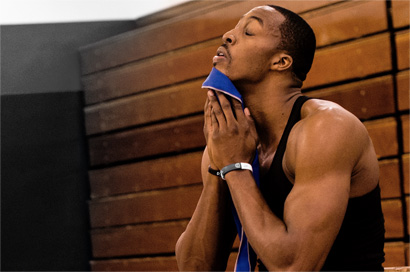- Shop ByProduct
- Shop BySport
- Technology
-
Athletes
- Carmelo Anthony
- Georges St-Pierre
- Adrian Gonzalez
- Dwight Howard
- Brandon Jennings
- Dwyane Wade
- Reggie Bush
- Serena Williams
- David Wright
- Ryan Tannehill
- Steve Nash
- Hunter Kemper
- Sarah Haskins
- Kevin VanDam
- Sergio Garcia
- Amanda Beard
- Gretchen Bleiler
- Mia Hamm
- Alonzo Mourning
- Jenny Fletcher
- Billie Jean King
- Carmelo Anthony
- Georges St-Pierre
- Adrian Gonzalez
- Dwight Howard
- Brandon Jennings
- Dwyane Wade
- Reggie Bush
- Serena Williams
- David Wright
- Ryan Tannehill
- Steve Nash
- Hunter Kemper
- Sarah Haskins
- Kevin VanDam
- Sergio Garcia
- Amanda Beard
- Gretchen Bleiler
- Mia Hamm
- Alonzo Mourning
- Jenny Fletcher
- Billie Jean King

Stay Cool
in Intense Heat
in Intense Heat
Sign up to download the Mission-KSI heat safety strategy pdf
STAY COOL
MISSION IS COMMITTED TO HELPING ATHLETES ELEVATE PERFORMANCE.
But the body does not work well when it is overheated. In fact, heat related illness is one
of the leading causes of death and disability among athletes.
But, heat illness is treatable and preventable.
Mission works with the Korey Stringer Institute to provide first-rate information, resources, assistance, and advocacy in order to help optimize the process of exercising safely, especially during intense exercise in the heat.
But, heat illness is treatable and preventable.
Mission works with the Korey Stringer Institute to provide first-rate information, resources, assistance, and advocacy in order to help optimize the process of exercising safely, especially during intense exercise in the heat.

PREVENTION
THINGS TO REMEMBER TO STAY COOL WHEN EXERCISING IN INTENSE HEAT
Heat related illness is more likely when the environment is hot and humid. Here are some key strategies to help stay safe:
HYDRATE
By maintaining appropriate hydration levels you can prevent an increase in core body temperature during intense exercise in the heat. It has been found that for every 1% loss in body mass via sweat, core body temperature will increase by .5°F. Since fluid needs are dependent on an athlete’s sweat rate, it is important that there is specific rehydration plan in place for each athlete! But, generally speaking the intensity of activity, body size, and environmental conditions are the three biggest factors that determine sweat losses.COOL YOUR BODY
By keeping your body cool, you can prevent a rise in core temperature! So remember, if you feel hot make sure to take steps to cool yourself including: decrease intensity of activity or take a break, lie in a cool, shady place or apply cooling towels to the body.TAKE BREAKS
It is important to have appropriate work-to-rest ratios based on environmental conditions and specific athlete fitness! Most importantly, increase the number and length of breaks and make sure there is always water nearby to hydrate!ACCLIMATIZE
Have athletes go through a heat acclimatization process at the beginning of an exercise period in order to help prevent exertional heat stroke. It will take time for the body to fully adapt to heat and other environmental factors so it is important to ease into activity and remember to stay hydrated! The first week in the heat is the most important time to think about heat safety (and whenever doing intense exercise in the heat).STAY SMART
It is important that athletes, coaches and parents alike are educated on the right way to stay cool and prevent heat stroke. Also on the list of things to know are the signs and symptoms of heat stroke to make sure any instances are treated as early as possible. And remember, whenever possible within the confines of organized sport, an athletic trainer should be on site to provide appropriate medical care, especially when athletes are being worked hard in the heat. But, if there is no medical care available, call 911 immediately and use some of our previously mentioned cooling strategies if heat stroke is suspected!TREATMENT
EVEN WHEN TAKING PRECAUTIONS, EXERTIONAL HEAT STROKE CAN HAPPEN.
The key to survival is education. Keys to Surviving Exertional Heat Stroke
RECOGNIZE EHS
Exertional heat stroke is when the body temperature is greater than 104 °F (only rectal temperature should be utilized to determine core temperature) accompanied by dysfunction of the Central Nervous System like dizziness, collapse, loss of consciousness, confusion and mood changes. Some early signs of EHS are headaches, dizziness and nausea. If any of these symptoms are present while exercising intensely in the heat, EHS should be assumed.
how to treat EHS
The go-to solution for EHS is cold-water immersion as soon as EHS is suspected. Facilities should have cooling tubs on site in order to ensure survival. Any cooling that can be done on-site prior to hospital transportation is imperative. If a cold-water bath is not available, other options include: dousing with cold water from shower, hose, or buckets; ice/water towels over entire body (and change out towels every few minutes). The number of minutes the athlete is hyperthermic will determine if they will live, have permanent damage, or die. Make Herculean efforts to cool as fast as possible.WHEN TO RETURN-TO-PLAY
Once a physician has evaluated an athlete, they should be able to return-to-play as long as they can tolerate exercise in the heat. Any predisposing factors that may have caused EHS should also be taken care of before an athlete makes a gradual and medically monitored return to sport. The return should be supervised by the athlete’s athletic trainer.GET INVOLVED
If you want to find out what health and safety policies related to youth athletes are in place in your state, or how you can work to get involved please visit the KSI website AT www.ksi.uconn.edu or e-mail ksi@uconn.edu
© 2014. All Rights Reserved.
MISSION Product™ Holdings, Inc.
- Contact Us
- International Partners
- USA
Sign up for email
Copyright © 2014. All Rights Reserved. MISSION Product™ Holdings, Inc.
Get in the Game.
Stay Informed.
Sign up for exclusive content / product updates /
athlete announcements from mission athletecare™.